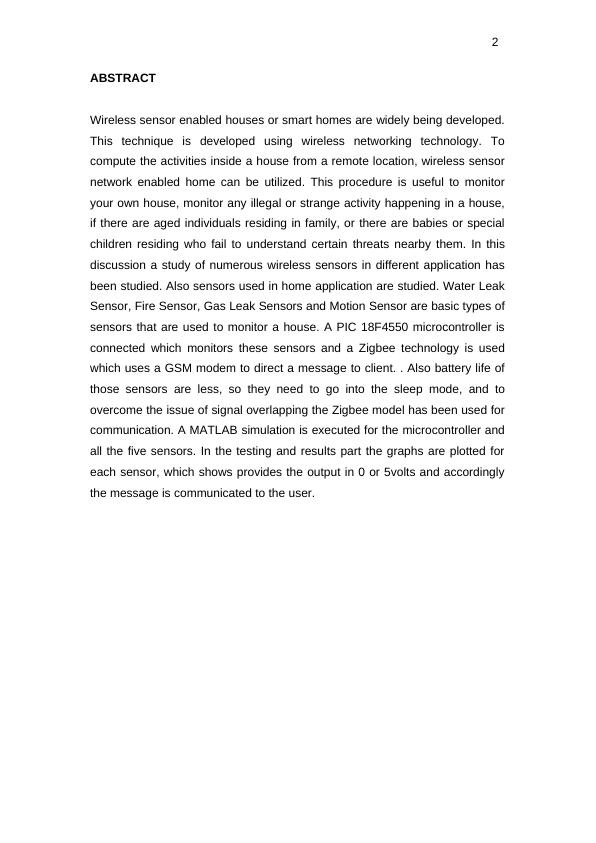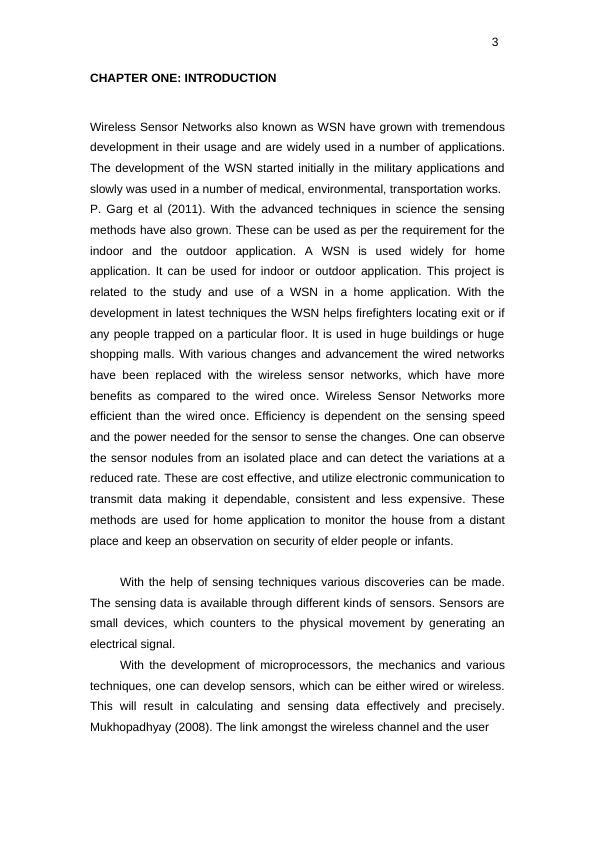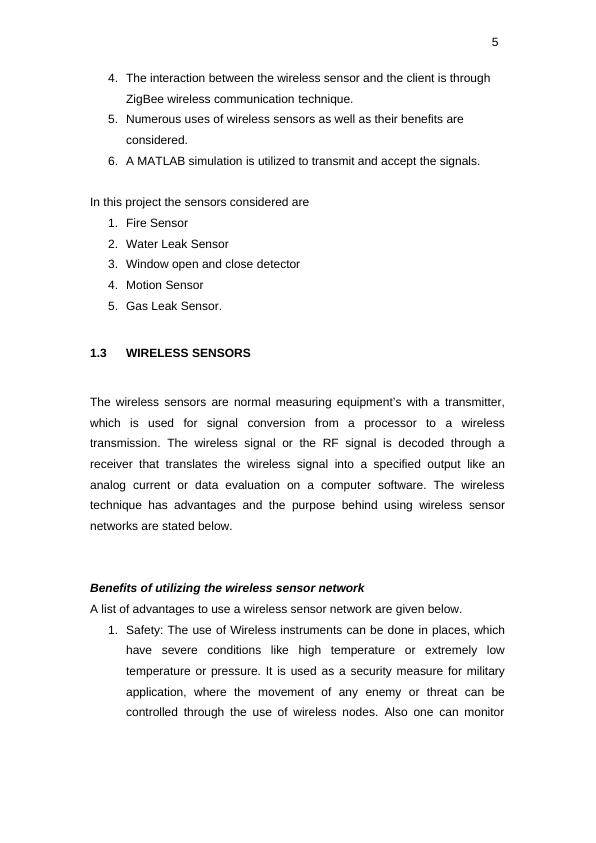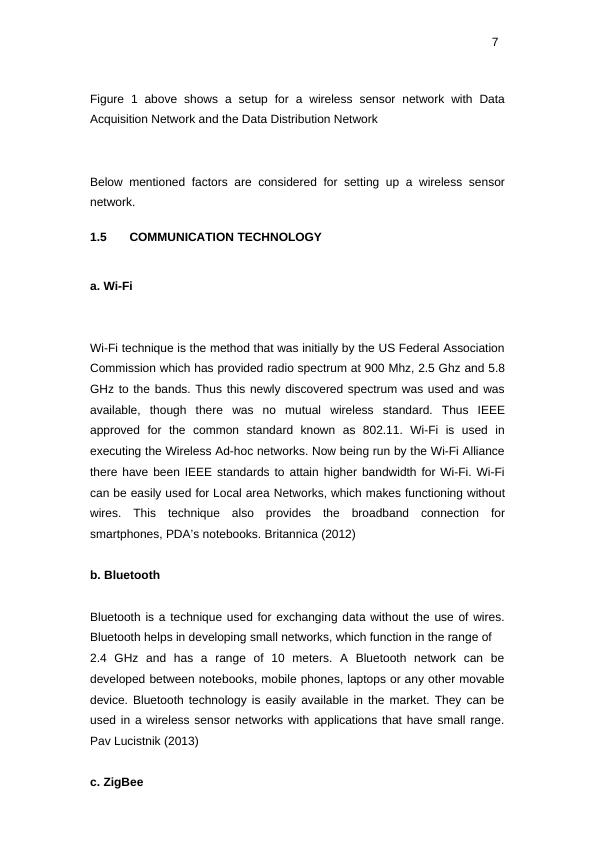Wireless Sensor Networks for Home Monitoring
Added on 2022-08-16
44 Pages9865 Words14 Views
1
WIRELESS SENSOR NETWORKS FOR HOME MONITORING
WIRELESS SENSOR NETWORKS FOR HOME MONITORING

2
ABSTRACT
Wireless sensor enabled houses or smart homes are widely being developed.
This technique is developed using wireless networking technology. To
compute the activities inside a house from a remote location, wireless sensor
network enabled home can be utilized. This procedure is useful to monitor
your own house, monitor any illegal or strange activity happening in a house,
if there are aged individuals residing in family, or there are babies or special
children residing who fail to understand certain threats nearby them. In this
discussion a study of numerous wireless sensors in different application has
been studied. Also sensors used in home application are studied. Water Leak
Sensor, Fire Sensor, Gas Leak Sensors and Motion Sensor are basic types of
sensors that are used to monitor a house. A PIC 18F4550 microcontroller is
connected which monitors these sensors and a Zigbee technology is used
which uses a GSM modem to direct a message to client. . Also battery life of
those sensors are less, so they need to go into the sleep mode, and to
overcome the issue of signal overlapping the Zigbee model has been used for
communication. A MATLAB simulation is executed for the microcontroller and
all the five sensors. In the testing and results part the graphs are plotted for
each sensor, which shows provides the output in 0 or 5volts and accordingly
the message is communicated to the user.
ABSTRACT
Wireless sensor enabled houses or smart homes are widely being developed.
This technique is developed using wireless networking technology. To
compute the activities inside a house from a remote location, wireless sensor
network enabled home can be utilized. This procedure is useful to monitor
your own house, monitor any illegal or strange activity happening in a house,
if there are aged individuals residing in family, or there are babies or special
children residing who fail to understand certain threats nearby them. In this
discussion a study of numerous wireless sensors in different application has
been studied. Also sensors used in home application are studied. Water Leak
Sensor, Fire Sensor, Gas Leak Sensors and Motion Sensor are basic types of
sensors that are used to monitor a house. A PIC 18F4550 microcontroller is
connected which monitors these sensors and a Zigbee technology is used
which uses a GSM modem to direct a message to client. . Also battery life of
those sensors are less, so they need to go into the sleep mode, and to
overcome the issue of signal overlapping the Zigbee model has been used for
communication. A MATLAB simulation is executed for the microcontroller and
all the five sensors. In the testing and results part the graphs are plotted for
each sensor, which shows provides the output in 0 or 5volts and accordingly
the message is communicated to the user.

3
CHAPTER ONE: INTRODUCTION
Wireless Sensor Networks also known as WSN have grown with tremendous
development in their usage and are widely used in a number of applications.
The development of the WSN started initially in the military applications and
slowly was used in a number of medical, environmental, transportation works.
P. Garg et al (2011). With the advanced techniques in science the sensing
methods have also grown. These can be used as per the requirement for the
indoor and the outdoor application. A WSN is used widely for home
application. It can be used for indoor or outdoor application. This project is
related to the study and use of a WSN in a home application. With the
development in latest techniques the WSN helps firefighters locating exit or if
any people trapped on a particular floor. It is used in huge buildings or huge
shopping malls. With various changes and advancement the wired networks
have been replaced with the wireless sensor networks, which have more
benefits as compared to the wired once. Wireless Sensor Networks more
efficient than the wired once. Efficiency is dependent on the sensing speed
and the power needed for the sensor to sense the changes. One can observe
the sensor nodules from an isolated place and can detect the variations at a
reduced rate. These are cost effective, and utilize electronic communication to
transmit data making it dependable, consistent and less expensive. These
methods are used for home application to monitor the house from a distant
place and keep an observation on security of elder people or infants.
With the help of sensing techniques various discoveries can be made.
The sensing data is available through different kinds of sensors. Sensors are
small devices, which counters to the physical movement by generating an
electrical signal.
With the development of microprocessors, the mechanics and various
techniques, one can develop sensors, which can be either wired or wireless.
This will result in calculating and sensing data effectively and precisely.
Mukhopadhyay (2008). The link amongst the wireless channel and the user
CHAPTER ONE: INTRODUCTION
Wireless Sensor Networks also known as WSN have grown with tremendous
development in their usage and are widely used in a number of applications.
The development of the WSN started initially in the military applications and
slowly was used in a number of medical, environmental, transportation works.
P. Garg et al (2011). With the advanced techniques in science the sensing
methods have also grown. These can be used as per the requirement for the
indoor and the outdoor application. A WSN is used widely for home
application. It can be used for indoor or outdoor application. This project is
related to the study and use of a WSN in a home application. With the
development in latest techniques the WSN helps firefighters locating exit or if
any people trapped on a particular floor. It is used in huge buildings or huge
shopping malls. With various changes and advancement the wired networks
have been replaced with the wireless sensor networks, which have more
benefits as compared to the wired once. Wireless Sensor Networks more
efficient than the wired once. Efficiency is dependent on the sensing speed
and the power needed for the sensor to sense the changes. One can observe
the sensor nodules from an isolated place and can detect the variations at a
reduced rate. These are cost effective, and utilize electronic communication to
transmit data making it dependable, consistent and less expensive. These
methods are used for home application to monitor the house from a distant
place and keep an observation on security of elder people or infants.
With the help of sensing techniques various discoveries can be made.
The sensing data is available through different kinds of sensors. Sensors are
small devices, which counters to the physical movement by generating an
electrical signal.
With the development of microprocessors, the mechanics and various
techniques, one can develop sensors, which can be either wired or wireless.
This will result in calculating and sensing data effectively and precisely.
Mukhopadhyay (2008). The link amongst the wireless channel and the user

4
can be established using modulation and coding and identifies the system
performance, use of the bandwidth and the signal power. Dawood et al (2013)
To attain better proficiency in the network certain factors like variation and
coding are important. A WSN has sensors placed in the given network. The
sensors are battery operated and the life span of the sensors depends upon
the amount of energy consumed by the transceivers. Wireless sensor
networks have more advantage as compared to the wired sensor networks.
These are adaptable and can be used in different locations to sense the
movement. The WSN networks may be symmetric or asymmetric and the
power utilized by the sensor nodes is less. A WSN can be combined with a
wireless communication system like Wi-Fi, GSM, or CDMA technique and a
mobile processing with an energy convertor, which can be integrated and
used for various applications. Most of the WSN methods have RF
communication along with the sensor unit. There are communication
techniques likeInfrared, Bluetooth, Zigbee, GSM and GPRS are used as per
the requirement and scenarios. A number of sensors are linked to a single
gateway unit, and are transformed into a huge Wireless Sensor Networks.
1.1 AIM
The primary objective of this discussion is observing a house with the support
of five altered wireless sensors. This process will be done by the MATLAB
simulation with the purpose to complete the microcontroller and transceiver
procedure.
1.2 OBJECTIVES
1. In this project a study about several uses of wireless sensors are
described and the categories of sensing devices for sensing any object
are described.
2. Five categories of sensors are utilized to observe the activities of
home. The sensors are monitored remotely through a microcontroller.
3. The features of numerous categories of sensors are analyzed and
discussed which are already available in the market.
can be established using modulation and coding and identifies the system
performance, use of the bandwidth and the signal power. Dawood et al (2013)
To attain better proficiency in the network certain factors like variation and
coding are important. A WSN has sensors placed in the given network. The
sensors are battery operated and the life span of the sensors depends upon
the amount of energy consumed by the transceivers. Wireless sensor
networks have more advantage as compared to the wired sensor networks.
These are adaptable and can be used in different locations to sense the
movement. The WSN networks may be symmetric or asymmetric and the
power utilized by the sensor nodes is less. A WSN can be combined with a
wireless communication system like Wi-Fi, GSM, or CDMA technique and a
mobile processing with an energy convertor, which can be integrated and
used for various applications. Most of the WSN methods have RF
communication along with the sensor unit. There are communication
techniques likeInfrared, Bluetooth, Zigbee, GSM and GPRS are used as per
the requirement and scenarios. A number of sensors are linked to a single
gateway unit, and are transformed into a huge Wireless Sensor Networks.
1.1 AIM
The primary objective of this discussion is observing a house with the support
of five altered wireless sensors. This process will be done by the MATLAB
simulation with the purpose to complete the microcontroller and transceiver
procedure.
1.2 OBJECTIVES
1. In this project a study about several uses of wireless sensors are
described and the categories of sensing devices for sensing any object
are described.
2. Five categories of sensors are utilized to observe the activities of
home. The sensors are monitored remotely through a microcontroller.
3. The features of numerous categories of sensors are analyzed and
discussed which are already available in the market.

5
4. The interaction between the wireless sensor and the client is through
ZigBee wireless communication technique.
5. Numerous uses of wireless sensors as well as their benefits are
considered.
6. A MATLAB simulation is utilized to transmit and accept the signals.
In this project the sensors considered are
1. Fire Sensor
2. Water Leak Sensor
3. Window open and close detector
4. Motion Sensor
5. Gas Leak Sensor.
1.3 WIRELESS SENSORS
The wireless sensors are normal measuring equipment’s with a transmitter,
which is used for signal conversion from a processor to a wireless
transmission. The wireless signal or the RF signal is decoded through a
receiver that translates the wireless signal into a specified output like an
analog current or data evaluation on a computer software. The wireless
technique has advantages and the purpose behind using wireless sensor
networks are stated below.
Benefits of utilizing the wireless sensor network
A list of advantages to use a wireless sensor network are given below.
1. Safety: The use of Wireless instruments can be done in places, which
have severe conditions like high temperature or extremely low
temperature or pressure. It is used as a security measure for military
application, where the movement of any enemy or threat can be
controlled through the use of wireless nodes. Also one can monitor
4. The interaction between the wireless sensor and the client is through
ZigBee wireless communication technique.
5. Numerous uses of wireless sensors as well as their benefits are
considered.
6. A MATLAB simulation is utilized to transmit and accept the signals.
In this project the sensors considered are
1. Fire Sensor
2. Water Leak Sensor
3. Window open and close detector
4. Motion Sensor
5. Gas Leak Sensor.
1.3 WIRELESS SENSORS
The wireless sensors are normal measuring equipment’s with a transmitter,
which is used for signal conversion from a processor to a wireless
transmission. The wireless signal or the RF signal is decoded through a
receiver that translates the wireless signal into a specified output like an
analog current or data evaluation on a computer software. The wireless
technique has advantages and the purpose behind using wireless sensor
networks are stated below.
Benefits of utilizing the wireless sensor network
A list of advantages to use a wireless sensor network are given below.
1. Safety: The use of Wireless instruments can be done in places, which
have severe conditions like high temperature or extremely low
temperature or pressure. It is used as a security measure for military
application, where the movement of any enemy or threat can be
controlled through the use of wireless nodes. Also one can monitor

6
locations, which are hazardous through a central monitor from a safe
remote place.
2. Convenience: Using the wireless sensors a network can be formed,
which helps to observe diverse locations through a user from a single
station, thus one can have central monitoring. Also a web page can be
developed through the wireless sensors that would provide access to
the web page from any place in the world.
3. Decreased Cost: since the nodes are wireless sensor nodes, the
expenses in having a wired connection with a ducting system and other
costly fittings can be eliminated. Omega Engineering (2009)
1.4 FEATURES OF WIRELESS SENSOR NETWORK
Wireless sensor networks have unwired nodes, which sense data. Nodes can
be instruments that consume less power. The sensor marks the actions that
are taking place and the collected data is transferred to a remote station
through wireless communication system like the RF communication. There
are a few limitations with respect to the size and cost, which in turn causes
restrictions on the energy, speed and the frequency.
Fig 1: Setup for a Wireless Sensor Network with a DAN and DDN
Source: Lewis et al (2004)
locations, which are hazardous through a central monitor from a safe
remote place.
2. Convenience: Using the wireless sensors a network can be formed,
which helps to observe diverse locations through a user from a single
station, thus one can have central monitoring. Also a web page can be
developed through the wireless sensors that would provide access to
the web page from any place in the world.
3. Decreased Cost: since the nodes are wireless sensor nodes, the
expenses in having a wired connection with a ducting system and other
costly fittings can be eliminated. Omega Engineering (2009)
1.4 FEATURES OF WIRELESS SENSOR NETWORK
Wireless sensor networks have unwired nodes, which sense data. Nodes can
be instruments that consume less power. The sensor marks the actions that
are taking place and the collected data is transferred to a remote station
through wireless communication system like the RF communication. There
are a few limitations with respect to the size and cost, which in turn causes
restrictions on the energy, speed and the frequency.
Fig 1: Setup for a Wireless Sensor Network with a DAN and DDN
Source: Lewis et al (2004)

7
Figure 1 above shows a setup for a wireless sensor network with Data
Acquisition Network and the Data Distribution Network
Below mentioned factors are considered for setting up a wireless sensor
network.
1.5 COMMUNICATION TECHNOLOGY
a. Wi-Fi
Wi-Fi technique is the method that was initially by the US Federal Association
Commission which has provided radio spectrum at 900 Mhz, 2.5 Ghz and 5.8
GHz to the bands. Thus this newly discovered spectrum was used and was
available, though there was no mutual wireless standard. Thus IEEE
approved for the common standard known as 802.11. Wi-Fi is used in
executing the Wireless Ad-hoc networks. Now being run by the Wi-Fi Alliance
there have been IEEE standards to attain higher bandwidth for Wi-Fi. Wi-Fi
can be easily used for Local area Networks, which makes functioning without
wires. This technique also provides the broadband connection for
smartphones, PDA’s notebooks. Britannica (2012)
b. Bluetooth
Bluetooth is a technique used for exchanging data without the use of wires.
Bluetooth helps in developing small networks, which function in the range of
2.4 GHz and has a range of 10 meters. A Bluetooth network can be
developed between notebooks, mobile phones, laptops or any other movable
device. Bluetooth technology is easily available in the market. They can be
used in a wireless sensor networks with applications that have small range.
Pav Lucistnik (2013)
c. ZigBee
Figure 1 above shows a setup for a wireless sensor network with Data
Acquisition Network and the Data Distribution Network
Below mentioned factors are considered for setting up a wireless sensor
network.
1.5 COMMUNICATION TECHNOLOGY
a. Wi-Fi
Wi-Fi technique is the method that was initially by the US Federal Association
Commission which has provided radio spectrum at 900 Mhz, 2.5 Ghz and 5.8
GHz to the bands. Thus this newly discovered spectrum was used and was
available, though there was no mutual wireless standard. Thus IEEE
approved for the common standard known as 802.11. Wi-Fi is used in
executing the Wireless Ad-hoc networks. Now being run by the Wi-Fi Alliance
there have been IEEE standards to attain higher bandwidth for Wi-Fi. Wi-Fi
can be easily used for Local area Networks, which makes functioning without
wires. This technique also provides the broadband connection for
smartphones, PDA’s notebooks. Britannica (2012)
b. Bluetooth
Bluetooth is a technique used for exchanging data without the use of wires.
Bluetooth helps in developing small networks, which function in the range of
2.4 GHz and has a range of 10 meters. A Bluetooth network can be
developed between notebooks, mobile phones, laptops or any other movable
device. Bluetooth technology is easily available in the market. They can be
used in a wireless sensor networks with applications that have small range.
Pav Lucistnik (2013)
c. ZigBee

8
ZigBee is almost a new technique used in wireless network depending on the
IEEE 802.15.4. This technique provides a range upto 100+ meters [8]. The
devices used in the ZigBee technique utilize less energy, thus they have a
longer battery life of almost 1000 days and above. This technique has more
advantages as compared to Bluetooth technique since it can cover a huge
area and uses less power, also this technique provide secure networking. Zig-
Bee is functionally is like radio bands which includes 868 MHz, 2.4 GHz and
915 MHz Mukhopadhyay et al (2008)
1.6 Communication Protocol and Routing in a WSN
In the technical infrastructure of Wireless Sensor Network there could be
various categories of interaction rules and methods for routing. The manner
used for data transmission and direction finding is determined by organization
of the sensors in the network. A normal communication pattern comprises of
packets of data that has a header for connection, frames to understand any
flaws in transmission process and rectify them. During the transmission of the
message a sensor node may use the handshaking method for routing to
transfer the message to the destination node to enhance the consistency and
the Quality of Service. The handshaking protocol helps to retransmit the
message, which failed to reach the destination node. To have an efficient and
a less expensive method another method known as CodeBlue is used in the
wireless networks to handle with the sensor nodes that have less calculation
abilities
1.7 Power Management
The wireless sensor nodes are distributed all over the place, the life of the
sensor nodes plays an important part and so does the power management
plays a significant role as well. Power management comprises of preserving
power, producing power and performs a significant part in rising the duration.
Huge amount of power gets dissipated in RF communication, because the
transmission power needed upsurges as the quadrangular of the span
amongst the destination node and source nodes. Appropriate management of
power approaches can reduce the power dispelled through the RF sensor
nodules. TDMA can also be used for saving power, since the node can
decrease the power between the time slots provided and wakes up in an
ZigBee is almost a new technique used in wireless network depending on the
IEEE 802.15.4. This technique provides a range upto 100+ meters [8]. The
devices used in the ZigBee technique utilize less energy, thus they have a
longer battery life of almost 1000 days and above. This technique has more
advantages as compared to Bluetooth technique since it can cover a huge
area and uses less power, also this technique provide secure networking. Zig-
Bee is functionally is like radio bands which includes 868 MHz, 2.4 GHz and
915 MHz Mukhopadhyay et al (2008)
1.6 Communication Protocol and Routing in a WSN
In the technical infrastructure of Wireless Sensor Network there could be
various categories of interaction rules and methods for routing. The manner
used for data transmission and direction finding is determined by organization
of the sensors in the network. A normal communication pattern comprises of
packets of data that has a header for connection, frames to understand any
flaws in transmission process and rectify them. During the transmission of the
message a sensor node may use the handshaking method for routing to
transfer the message to the destination node to enhance the consistency and
the Quality of Service. The handshaking protocol helps to retransmit the
message, which failed to reach the destination node. To have an efficient and
a less expensive method another method known as CodeBlue is used in the
wireless networks to handle with the sensor nodes that have less calculation
abilities
1.7 Power Management
The wireless sensor nodes are distributed all over the place, the life of the
sensor nodes plays an important part and so does the power management
plays a significant role as well. Power management comprises of preserving
power, producing power and performs a significant part in rising the duration.
Huge amount of power gets dissipated in RF communication, because the
transmission power needed upsurges as the quadrangular of the span
amongst the destination node and source nodes. Appropriate management of
power approaches can reduce the power dispelled through the RF sensor
nodules. TDMA can also be used for saving power, since the node can
decrease the power between the time slots provided and wakes up in an

End of preview
Want to access all the pages? Upload your documents or become a member.
Related Documents
MN691 Research Methods and Project Designlg...
|30
|6018
|236
IOT and Smart Homes Analysis 2022lg...
|4
|767
|25
Wireless Sensor Network Technologies for Temperature Monitoringlg...
|33
|7757
|21
Internet of Things (IoT) Assignment Paperlg...
|4
|764
|342